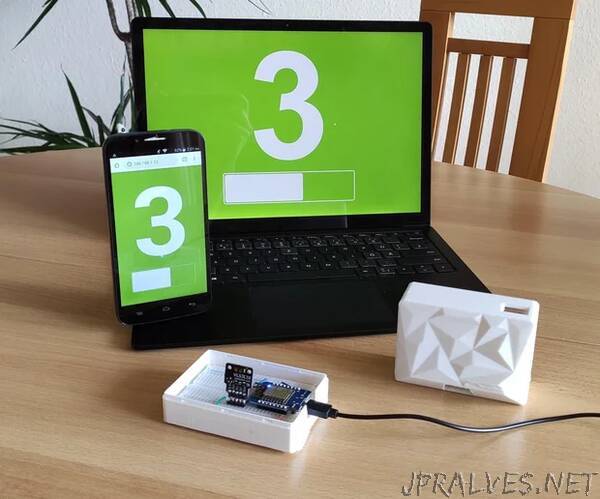
“Let’s start of with a question: What is a people counter? …. Well, it is a device, that counts the amount of people passing by. They are usually placed in doorways and can be used to see how many people are in a room or a restaurant or a store at any given time.
The people counter that I am going to show you today uses a laser to count the people and can be connected to any device that has a webbrowser using WiFi. This allows a simple web UI to be displayed on all kinds of devices as seen in the fifth image. I also attached a little video so you can see it in action.
It is a neat little project, that includes electronics, cool new sensor technology, Arduino programming and even a little bit of 3D printing. And the best part: You can build one yourself for under 20 €.
The backstory
My people counter journey started way back in 2019, when I was working on an unrelated IoT project. I was using a tiny little distance sensor called the VL53L1X (more on that in step 3) and saw a proof of concept video from ST Microelectronics that showed it being used as a people counter. Fast forward to 2020 and we have a global pandemic. One that requires us to social distance. For stores, restaurants, gyms and all other kinds of enclosed public places this means that it is now necessary to limit the amount of people inside. A job for a people counter. I was just waiting for them to appear in any store in no time but that didn’t happen. Here in Germany only a hand full of shops started using electronic people counting systems. The rest placed a person at the store that counts manually.
I was wondering why that is and did a little bit of research. To me it seemed that there were three major reasons:
Nobody knows that electronic counters exist
People Counting Systems are too expensive (Especially with a big display for the customers)
The systems are complicated and require technicians for installation
I remembered the proof of concept from ST which used a really cheap sensor. The demo was very basic and was missing things like a proper user interface but it looked promising. Could that be a better people counter that addresses the above issues?
Fast forward to today and I spent half a year developing a working prototypes and learned a ton of things about people counters.
What you can find in this Instructable
I want to share my knowledge and show you how you can rebuild my latest prototype.
If you want to learn something interesting. If you are looking for a great Internet of Things project, be it for school, university or just a weekend project, you have come to the right place :)
I tried to make this Instructable educational, easy to understand and interesting at the same time. If you just want to build your own people counter and don’t care about the theory, you only need 3 steps marked with “Making”. The parts marked with “Theory” give you a lot of extra knowledge but can be skipped.
We are going to start with the theory. I am going to explain how a simple people counter works. We are also going to take a short dive into the different types of people counters that are already available and get a glimpse at how those systems work. Then we are going to get into our laser people counter and all of its inner workings.
Finally we get to the interesting part: Making your own people counter. Which is 3 steps.
Assemble the Hardware
Upload the Software
Connect and mount the counter
In the end we are going to take a look at the weak points and possible improvements that I discovered. As I mentioned, this is still a prototype. It is useful but has a couple of rough edges here and there.
Here is what you need
to build yourself a simple laser people counter
WEMOS D1 Mini AliExpress | Amazon DE
VL53L1X ToF Sensor Module AliExpress | Amazon DE
Small Breadboard AliExpress | Amazon DE
Jumper wires AliExpress | Amazon DE
long Micro USB Cable AliExpress | Amazon
USB Power Brick AliExpress | Amazon
3D printed enclosure (optional) STL Files in step 5
Tools:
Soldering iron
Laptop with Arduino IDE
3D Printer (optional)”
